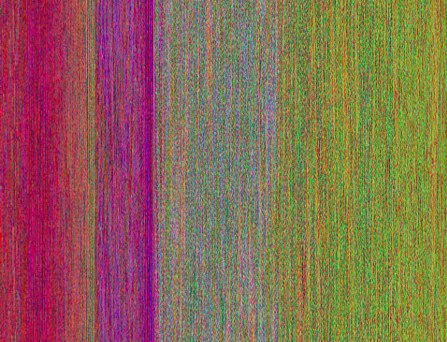Aesthetics of Glitch
Stacey Mason

In response to yesterday’s post on databending, someone asked me, “Aren’t you just creating noisy files?” Perhaps. But as Cage would argue, there’s beauty in the noise, and that’s precisely the appeal.
When you open an image in a text editor, the editor will display the raw data of the image file, usually using ASCII or UTF characters. Each character of the code stands for a series of binary inputs that allows the computer to read and display the image file, but to the average user, it’s gobbledygook.
Much of the experimentation I’ve been doing with databending attempts to replace the illegible code with words that we understand. The computer is still not reading the words for any meaning (like a programming language) but rather as a string of characters with each character providing instructions, just as it would with the symbols we replaced.
Sure, there is a case here for phantom signifiers, and the separation of signifier from signified; the computer and I are not “communicating” despite using the same signifiers, but I’m not interested in that. Other generative forms are already exploring the separation of word and meaning and the beauty of typeface as visual art. Those ideals might factor in, but my focus is instead on finding connections, not dissociations. What are the connections between the original image, and the words I’ve placed into the code? Is the code more interesting because of it? Have I removed something from the code and to what significance? Finally, how do the mood and aesthetics of the new image fit with the mood and aesthetics I’ve imparted into the code?
The process of (re)placement is what gives the work meaning.
The image avove is interesting for it’s color and texture. It’s more interesting when you see the original, and even more interesting when you know that I came to the glitched version by replacing symbols $,¢,®, and © with lines from Elliot: “THIS IS THE WAY” “THE WORLD ENDS” “NOT WITH A BANG” “BUT A WHIMPER” respectively. The glitched image is merely an artifact for the real meaning, which is the act of deliberately chosen character replacement.
Is the code noisy? Yes. But we now have a work that we can judge against some of the critical practices of poetry. We have language emerging from noise: repetitive, chaotic, and beautiful. We have not ignored the words’ signified meaning, but rather used those connotations to enrich the process.
